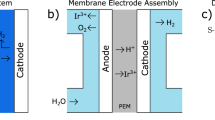Abstract
The aim of this study is to investigate the multi-day behavior of the electromotive force (EMF) between Pt and reference Ag/AgCl, KClsat. electrodes immersed in various aqueous systems (deionized water, 1 × 10−3 M H2SO4 solution and 0.15 M KCl solution) at 32 °C and also at ambient temperature, without oxygen removal and redox species introduction. The control test of EMF behavior in the presence of redox species was performed with cyanide complexes of Fe2+ and Fe3+ ions at ambient temperature. In experiments with deionized water, systems were protected against the influence of daylight and static electricity. The results have shown diurnal oscillations of EMF in all investigated systems with amplitudes in the range ≈ 1 to 25 mV depending on applied experimental conditions. EMF oscillations in deionized water were independent on the applied temperature and yielded amplitudes of 15–25 mV in daylight regime, and only a few mV when protected from its influence. The effect of electrostatic electricity was not observed. Diurnal EMF oscillations with the amplitudes ≤ 5 mV were observed individually in 0.15 M KCl solution, redox system and after 4 days of investigation in H2SO4 solution. Results presented in this work pointed out that the behavior of Pt–oxygen electrode is specific and very complex, even in the simplest system such as deionized water. To investigate the origin of the observed EMF oscillations and the application of Pt–oxygen electrode in in situ multi-day dynamics studies under open-circuit potential condition, additional theoretical and experimental methods and particularly electrochemical ones, must be applied.




Similar content being viewed by others
References
Bancroft WD (1892) Z Physik Chem 10:387–409
Fredenhagen C (1902) Z Anorg Allgem Chem 29:396–458
Hoare JP (1967) In: Delahay P (ed) The oxygen electrode on noble metals, 1st edn. Wiley, New York
Foerster F (1909) Z Physik Chem 69:236–271
Klemenc A (1939) Z Physik Chem 185A:1–36
Naray-Szabo StV (1927) Z Elektrochem 33:15–20
Schoch EP (1910) J Phys Chem 14:665–677
Tammann G, Runge F (1926) Z Anorg Allgem Chem 156:85–93
Böld W, Breiter M (1961) Electrochim Acta 5:145–160
Ershler B, Frumkin A (1939) Trans Faraday Soc 35:464–467
Giner J (1959) Z Elektrochem 63:386–397
Pearson JD, Butler JAV (1938) Trans Faraday Soc 34:1163–1170
Schuldiner S, Roe RM (1963) J Electrochem Soc 110:332–338
Visscher W, Devanathan MAV (1964) J Electroanal Chem 8:127–138
Watanabe N, Devanathan MAV (1964) J Electrochem Soc 111:615–619
Hickling A (1945) Trans Faraday Soc 41:333–339
Kalish TV, Burshtein RKh (1951) Dokl Akad Nauk SSSR 81:1093; (1953) 88:863
Luk’yanycheva VI, Bagotskii VS (1964) Dokl Akad Nauk SSSR 155:160
Obrucheva AD (1952) Zh Fiz Khim 26:1448
Ershler B (1947) Discussions Faraday Soc 1:269–277
Schuldiner S, Warner TB (1965) J Electrochem Soc 112:212–218
Richards WT (1928) J Phys Chem 32:990–1005
Devanathan MAV, Rao MLB (1962) ASTIA Rept No AD 291763
Hoar TP (1933) Proc Roy Soc (London) A142:628–646
Bockris JO'M, Huq AKMS (1956) Proc Roy Soc (London) A237:277–296
Stojiljković AS, Blagojević SN, Čupić ŽD, Anić S (2017) Multiday oscillatory dynamics of aqueous systems, XXXVII Dynamics Days Europe, Szeged, Hungary, The book of abstracts p. 232
Ansuini FJ, Dimond JR (1994) Mat Perf 33:14–17
Bard AJ, Faulkner LR (2001) Electrochemical methods, fundamentals and applications, 2nd edn. Wiley, New York
Jaksic JM, Jaksic MM (2017) Croat Chem Acta. https://doi.org/10.5562/cca3201 (in press)
Acknowledgement
Great gratitude is owed to Prof. Teresa Kowalska from the Institute of Chemistry, University of Silesia, Poland and research of her group related to amino acids for the inspiration to start this research. The support of this research by the Ministry Education, Science and Technological Development of Republic of Serbia through the Project No. 172015 is gratefully acknowledged.
Author information
Authors and Affiliations
Corresponding author
Rights and permissions
About this article
Cite this article
Stojiljković, A.S., Sužnjević, D.Ž. & Blagojević, S.N. Open-circuit potential of a Pt electrode immersed in different aqueous solutions. Reac Kinet Mech Cat 123, 165–175 (2018). https://doi.org/10.1007/s11144-017-1330-8
Received:
Accepted:
Published:
Issue Date:
DOI: https://doi.org/10.1007/s11144-017-1330-8




